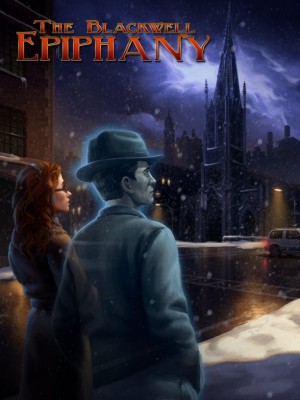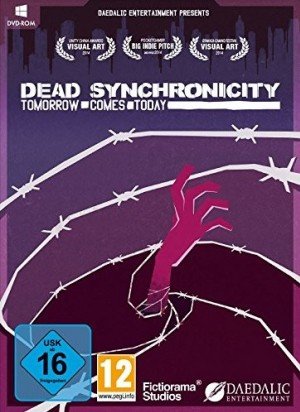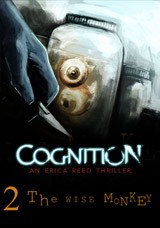AdventureX 2013: Preview round-up page 4
Events Coverage
Reporting from E3, GDC, AdventureX, Gamescom and other gaming events around the world

There was a whole lot more to AdventureX 2013 than the diverse range of talks covered in the first part of our round-up. There were over a dozen developers there to show off their games-in-progress as well, many of which we got to play ourselves. Here's what we discovered.
Broken Sword 5: The Serpent's Curse – Charles Cecil
Charles Cecil was more than happy to share a few tales and anecdotes of how he ended up in the industry, starting with the text game Adventure B. He says he enjoyed meeting the players of his game whenever he was selling them, as publishers and distributors were not part of the chain back then. At the time, developers went to game shows and expos and sold their games directly to their customers.
Later, with Revolution Software, Charles worked on Lure of the Temptress. He submitted a list of titles to the publisher, and at the bottom, as a joke, he put "Lure of the Temptress". When the publisher got back saying they liked that name best, he answered that there were two problems with the name: there was neither a “Lure” in the game nor a “Temptress”, so the publisher asked him if he could rewrite the game to include both. Charles then worked on Beneath a Steel Sky and the first two Broken Sword games, which sold very well (a million copies) and of course garnered tremendous critical acclaim.
The years from 1996 to 2006 are what Charles likes to call "The PlayStation Age", when large publishers commissioned games. They had to be made in about a year and a half and they had to be 3D in order to sell. Broken Sword 3 and 4 were made during these years. Toward the end of this period, Revolution was losing money and publishers did not want to invest in such a niche genre. They tried to reinvent the genre, but to no avail.
Charles Cecil at AdventureX (video by Michael Stein, Adventure-Treff)
Then in 2007, a huge change came with the release of the iPhone. The platform allowed for direct sales without going through retail channels, which meant the developers got 70% revenue instead of maybe 7%. It also meant they could be in direct contact with buyers again. In 2010, Revolution released Broken Sword: Shadow of the Templars – Director's Cut, adding a new story segment with two hours of extra gameplay, close-up facial expressions drawn by Dave Gibbons, and a help system.
Having released the first part of Broken Sword 5: The Serpent's Curse just before AdventureX, Charles also touched on his successful Kickstarter campaign and the vision behind it. In the pitch video, he had to convey what the game was all about in a very short time, so they made sure they communicated the humour, the quality, the relationship between George and Nico, and the fact that this was a return to 2D. The project was timed to neatly coincide with gamescom, the large games convention in Germany, so that Charles could show the pitch video to journalists, and a week later when the crowdfunding campaign went live there was an abundance of press coverage.
The design team kept a close eye on Kickstarter comments and when some remarks were made about the shape of George's chin, they decided to change it. There was more valuable feedback like that, and when the campaign ended the company had received $770,000 instead of the $400,000 they had asked for, which meant a couple of stretch goals had also been achieved.

Broken Sword 5: The Serpent's Curse
A couple of weeks ago, Revolution had to make a tough decision, as it became apparent they couldn't finish the game before Christmas as promised, so they had to either delay the game or split it into two parts and release just the first. They chose the latter option, and on December 4th 15,000 backers plus the many other adventure fans eager to buy it were waiting anxiously for the game to become available on Steam. Revolution had been working on the final fixes all day, and the game had to be on the network by 6pm. To celebrate, they had planned a live video stream starting at 6:30. When the upload finished a couple of minutes before six o clock, it became apparent that the installer had somehow become broken... Fortunately, they were able to fix it relatively quickly and around 7:00 they could finally start the live stream. In the long run, quality is all that matters, according to Charles, and also what people will remember you for.
Charles and his team are very satisfied with the feedback about the game so far, both the critics’ reviews and the messages they’ve receive through social media. The second part of the game will be out at the end of January, and Charles claims that the pace will be a bit quicker and provide another five or so hours of gameplay.
J.U.L.I.A.: Among the Stars – Jan Kavan
Jan Kavan's demo of J.U.L.I.A.: Among the Stars kicked off the event. The new title (which was chosen by its Indiegogo backers on the game's forums) reflects the new direction the developers are taking. It is no longer a straight "enhanced edition" but boasts 60% more content, full HD graphics, a new soundtrack that is procedurally generated and many other new features. Jan had several new backgrounds and animations to show, including a slick demonstration of how MOBOT – the giant robot that lands on distant planets and sends information to astrobiologist Rachel Manners and J.U.L.I.A., the ship’s A.I., back on board the spaceship – can detach part of itself to enter small spaces like the corridors and sleeping quarters of research stations. Even though the backgrounds themselves are still mostly static in nature, a lot of small animations make the scenes more lively. Also new is the high number of interactive hotspots, some of which are entirely optional, providing extra tidbits of information for thorough players.
 |
Jan Kavan displays J.U.L.I.A.: Among the Stars
|
One of the key features of the game is the interaction with datapads and similar items to figure out the backstory. Different crew members have different views of events, and although none of their stories may be entirely accurate, you can piece together what really happened by combining several incorrect or incomplete accounts, assumptions and allegations. An in-game journal keeps track of the tasks you have completed and what you are currently working on, so if you come back to the game after not playing for a while you can easily get back on track. It also stores important information such as key codes and passwords so you don't have to write them down on a piece of paper – unless you really want to; you can play a “hardcore” mode in which the journal does not store these for you.
In a separate session later in the day, Jan delved deeper into the music of J.U.L.I.A.: Among the Stars. An accomplished musician and composer himself, he claimed that music in video games is very important for setting the mood and providing an emotional guide, but it can also annoy when it repeats too much or is boring, especially when you are stuck in a game and have to listen to the same bit of music over and over again. When the music stops, there still are background sounds to consider, as together they combine to form the aural backdrop for a story.
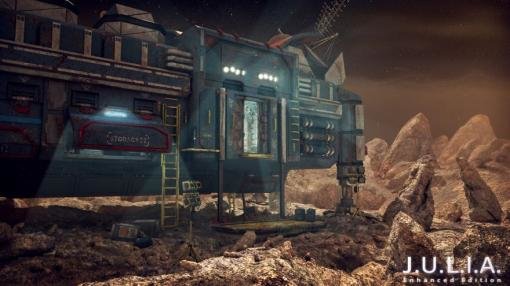
A better look at one of J.U.L.I.A.: Among the Stars' graphically enhanced environments
Jan wanted to create something special for J.U.L.I.A., a procedurally generated soundtrack that responds to the player’s actions. For instance, if you walk down a corridor towards something that scares you, the music should adapt. By starting with a full audio track and breaking it down into individual layers, a composer can use a basic melody and add or remove layers based on what players do in the game. Jan also explained the use of “sound objects”. These are very short tracks lasting just a few seconds each. There can be hundreds of these sound objects as they don't take up much file space, and the developer can create dynamic rules for their implementation so that the music keeps subtly changing and the soundtrack is never too repetitive. Transitions can be made seamlessly by adding and subtracting various layers and changing the percentage of sound objects used. The examples Jan gave made it sound like we have something to look forward to in J.U.L.I.A. when the updated version is ready around the end of the first quarter of 2014.
Blackwell Epiphany – Dave Gilbert
Dave Gilbert gave some unique insight into the history of the Blackwell games, outlining what lessons he learned from the feedback he received after each game. When he first started designing games, he wanted them to be epic and his design documents spanned 100 pages. He wanted to have the best graphics with excellent effects and rousing music but he couldn't pay anyone. It took four months to create just one background and two character animations, so Dave quickly realized he'd have to take a few steps back, be realistic and set actual goals.
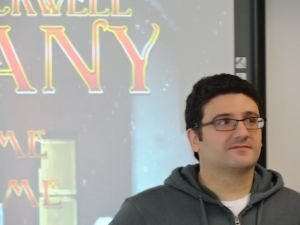 |
Dave Gilbert |
Due to budget and time restrictions, he chose to use the 1990s-era pixel art style, and on a budget of $5,000 he created The Blackwell Legacy. In hindsight, he says the game had a horrible intro; the protagonist, Rosa – a medium who can talk to ghosts and guide them into the afterlife – was too socially awkward; it dumped too much info onto the player; and didn't take enough advantage of the unique abilities of Joey, Rosa's inseparable ghostly companion. People still liked the game, though.
For Blackwell Unbound, Dave changed the dynamics a lot and made Joey a playable character with puzzle and gameplay possibilities. This time around, Dave kept the intro short and snappy and the story relatively simple. Yet he felt the structure was off, with lengthy investigations followed by a very short wrap-up. The "notebook" interface that let players combine notes and clues did not work properly either. When he removed it for The Blackwell Convergence, along with introducing more “big” moments and a self-contained intro as well as making Rosa a bit more likeable, players complained that they missed the clue-combining. Blackwell Deception saw the return of the notebook clue combinations, but in a revamped form that gave players clues they would never have found on their own. The story became more personal and the motivation to find out more about what was happening grew stronger and more emotional.
The fifth and final game in the series, Blackwell Epiphany, is currently in development and will have tons of atmosphere, as demonstrated by a couple of snowy scenes we saw from the intro. It will take Rosa and Joey to some outdoor locations, as opposed to just offices and apartments in the previous games, and promises to end the series in an awesome way. Dave has been working on Epiphany full-time for about a year now, and started designing it six months before that. The game is now at the beta testing stage.

Blackwell Epiphany
Epiphany’s intro will be self-contained once more, starting with Rosa and Joey waiting for their detective contact outside a building. When he doesn't show up, the pair will have to find another way to get into the building and find out what happened there, introducing the player to the core game mechanics like the fact that Joey can't move too far away from Rosa. This game has a new feature that is used in some puzzles. It is now possible to call the other character when they are in a different room, and if it is possible for them to move to where your current character is they will do so. Rosa leaves footsteps in the snow, which looks nice (and is also important in an easter egg). Dave is cooperating with Ben Chandler for the character art.
When Epiphany is done, Dave plans to do just standalone games from now on, as no matter how good the xth game in a series is, it is always tied to that game that was made y years ago and you may not have been as good a designer back then. He also has some games to publish in the pipeline, and his wife Janet is writing a game as well, so there's still plenty to look forward to from Wadjet Eye Games.
Heroine’s Quest: The Herald of Ragnarok
Started in 1999 by AGS member Radiant (Pieter Simoons), Crystal Shard has produced many well-known freeware games in the intervening years. A Tale of Two Kingdoms, released back in 2007, continues to be among the top five downloads from the AGS website on a regular basis even now. Other games such as the character-driven sci-fi game Quasar and Harry Potter spoof Warthogs have also received acclaim from players. Since its inception, over one hundred different people have worked under the Crystal Shard name, with teams ranging from twenty people to just a handful of core personnel. Some have stayed on for several projects, including Australian artist Elissa Ng, who is behind the extensive artwork in their latest production. In all, eighteen games have been made under the Crystal Shard umbrella, and all of them are still available at the official website.
 |
Pieter Simoons |
The game demonstrated at this year’s AdventureX is the one that Pieter always wanted to write, but initially did not have the skills to accomplish. Viewing some of the studio’s previous releases, it is clear that Pieter is a fan of Sierra, and Quest for Yrolg, where you are a villain setting out to thwart the heroes for a change, was a step toward his dream. In Heroine’s Quest: The Herald of Ragnarok, he has finally realised his ambition to create a game truly in the style of the Quest for Glory series. Many of the features of that series have been carried over into this fan-made quest. Whilst the protagonist’s gender is preset, players can choose one of three classes, Warrior, Sorcerer or Thief, and there is even a quest to attain the Paladin class. The choice of class gives different skills and therefore different ways of solving the various challenges. There are also mercenary guild houses, where players can rest and hone their abilities. To create the game world, Pieter has drawn on his longtime fascination with mythology, in particular the Nordic myths. Frost giants, svartalfs and two-headed trolls all play their part in the grand quest to save the land from falling into Fimbulwinter, the prelude to the apocalypse that is Ragnarok.
With the final release of the game imminent, an extensive demo was on offer at AdventureX. The graphics are of a moderately low-resolution in honour of the game’s inspiration, but are still strikingly beautiful. The opening section includes the desolation of a snow-swept forest and the welcoming warm interior of a blacksmith’s forge. These scenes are animated as well, with wind-blown vegetation and a flickering fire. With screenshots of later levels showing the svartelves’ subterranean home, a vibrant world is clearly out there waiting to be discovered. In conversations, large on-screen portraits appear, with shadows giving real depth and life to the characters depicted. These portraits also move smoothly when the characters speak. What’s more, every character is fully voiced, each having a distinctive personality of their own, from the boy with dreams of heroism to the bar owner with a calm and collected view of the world. But it is not just their faces and voices that make the characters seem alive. Taking a cue from Revolution’s Virtual Theatre, the characters do not just stand around waiting to interact with the hero, but have lives of their own instead. People move around at various times of the day, fulfilling their own needs and duties without any interaction from you.
Heroine's Quest: The Herald of Ragnarok trailer
The story also promises to be an epic one. Things look bad for our heroine from the outset, as she is buried under an avalanche created by a two-headed troll. Fortunately, this troll is stupidly unaware that humans don’t turn to stone in sunlight, leaving her to be rescued by a local villager rather than finishing her off. Initially weak from her ordeal, she is unable to travel far from the home of her rescuer. Then the local lord, recognising the hero his beleaguered realm sorely needs, enlists her aid. Dealing with the local difficulties is just the start, as the last of the frost giants, Egther, seeks the bearers of the magical artefacts that will allow him to put his master plan into action. Of course, being on a grand quest is not enough to stop a true hero from engaging in a few side quests on the way. Deliver a letter to a rival village. Gather herbs for the local magician. For the really ambitious, there is even a riddle game that requires you to search the length and breadth of the world for new riddles and their solutions.
So how much is all this gaming goodness going to set you back? To the astonishment of all attending the demonstration, this epic tale is to become available for free very shortly. Keep an eye on the Crystal Shard website for the upcoming release.
Dead Synchronicity: Tomorrow comes Today
Fictiorama Studios consist of three brothers from Spain: Luis, Mario and Alberto Olivan. They have been working on their first game full-time for a couple of months now, having started in the summer of 2012. Dead Synchronicity: Tomorrow comes Today will be a classic point-and-click adventure game, with a very specific, expressionism-like, angular style of graphics. The game will be released in two parts, of which Tomorrow comes Today is the first.
 |
Two-thirds of brother team Fictiorama Studios |
The plot involves a global catastrophe – a series of earthquakes and other natural disasters called the Great Wave – that has left the world without electricity and without communication. An illness is spreading that gives its victims (dubbed "dissolveds") special cognitive abilities through which they learn certain things about the past (even before they were born) and the future, but then they die, dissolving into a puddle of blood. Michael, the main protagonist, wakes from a coma and suffers from amnesia. He has to find out not only who he is, but also if there is a relationship between the Great Wave and the illness, and he has to hurry because at some point the past, present and future will dissolve and become one (the moment of dead synchronicity).
Meanwhile, the army has taken control of the world and people (like Michael) who've lost their homes, jobs or family due to the Great Wave are locked away in refugee camps that are effectively more like concentration camps. The first game will take place inside such a camp and in a partially destroyed city. There will be plenty of gore and violence.
As two of the brothers play in a rock band, the style of the musical score was easily decided. Kovalski is creating the soundtrack especially for the game, and their music is a mix of rock and giallo ('70s Italian movie soundtracks). At the moment, it is not certain whether there will be full voice acting in the game, voiceovers only during dialogues, or none at all, as that depends on financing. So far, the brothers are using their own money, combined with a loan from the Spanish government. They are thinking about running a Kickstarter campaign as soon as they have a proper demo to show, which will probably be in the spring. If successful, the game should be released sometime in 2014 with the second part following a year later.
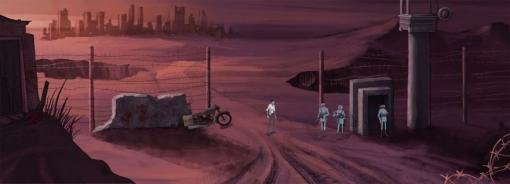
Dead Synchronicity: Tomorrow comes Today
At AdventureX, a short playable demo was available, and although there were no puzzles implemented yet, the gameplay seemed very intuitive. With the left mouse button you control Michael (in a third-person view), and when the cursor moves over a person or object two options appear for contextual interaction: Look or Use/Talk/Open. Inventory is used for combining items or using them with something in the environment. Whenever you start a dialogue, the game automatically and smoothly zooms into a close-up of the characters, with conversation options displayed at the bottom of the screen. If you do not move for a while, the background changes. This is a result of the way the Great Wave affects Michael, but he himself does not understand what is happening to him.
The Slaughter
Alec Francois was showcasing his game The Slaughter at AdventureX, which occurred during the final days of the Kickstarter campaign that has since successfully ended. In this point-and-click adventure set in the Victorian era, Sydney Anderson is a down-and-out private detective, making money by finding lost pets. In the prologue, he is in a park looking for a dog, and when things don't go as expected he ends up in a pub and gets drawn into the plot of a serial killer. The focus is on character development, dialogue and interactions. Dialogue options are displayed at the bottom of the screen in the form of two or three large buttons with a sentence each. The player will not have full control over Sydney's responses, as the options shown are just an indication of the gist of what Sydney will actually say, which can lead to unexpected results. Usually there will be one option that is quite obviously the “correct” choice to advance the story, with one or two alternatives that have a dark sense of humour.
 |
Alec Francois demos The Slaughter |
In some games, the protagonist will go through some pretty disturbing experiences like seeing dead bodies, yet their personality never changes. Sydney will be affected by the things he witnesses. Another important feature of the game is the Dream Room, a room that is abstract and strange but doesn't really surprise Sydney as dream locations usually feel natural to him. The room evolves throughout the game, with objects being added as references to what he has seen in the waking world, and a plant slowly growing to allow access to an additional room at a certain stage. There is no inventory while in the Dream Room, but it will have puzzles in the form of interactions forming a chain reaction.
Alec is just a one-man development team (Brainchild). He left his job as a creative writer to create The Slaughter. Initially he had not planned to include any voice acting, but at AdventureX he talked to many people who convinced him of the added value of voices and is now thinking about including them. Although the Kickstarter has ended, you can still donate (and pre-order) through Paypal.
Jason the Greek
Another Kickstarter that ended successfully shortly after the expo is Jason The Greek, by British developer Kris Fosh. Jason The Greek is a point-and-click adventure set in ancient Greece, taking heavy influences from Star Trek (as Fosh puts it, the game is like Jason and the Argonauts meets Captain Kirk). An episodic series, the first chapter (of a planned three) is called The Ladies of Lemnos. Kris had a short playable demo available, which can now be downloaded from the official website. In it, Captain Jason and his crew are on an epic quest to find the Golden Fleece, but Jason finds himself washed ashore after a fluke wave throws him overboard. Now he has to find a way off the island to rejoin his crew.
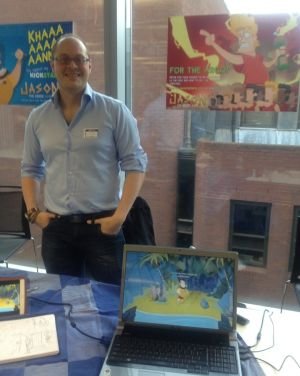 |
Jason the Greek's Kris Fosh |
The game's bright, cartoony graphics and abundance of silly remarks ooze atmosphere and quality right from the start. There are currently no spoken voices, and Jason is only accompanied by the sounds of the waves and wildlife on the island, but voice acting is one of the reasons the Kickstarter was needed (as well as translations and even better animations). The interface takes a little getting used to, as there are no mouseovers to indicate which objects are interactive. A left-click makes Jason walk, while right-clicking cycles through options like Look (eyes), Take (fingers) and Talk (Greek symbols). By right-clicking once and moving the Look cursor around the screen, you can see which objects are interactive as the eyes that are normally half-closed will fully open. Left-clicking with the eyes will get you a (funny and lengthy) description of an object or person and by right-clicking again to switch to Use you can then interact. The same applies to objects in your inventory (which is located at the bottom of the screen and autohides when you don't need it), as you need to right-click a few times then left-click to pick them up and use or combine them. It is a bit cumbersome, but it works fine once you've done it a few times. The Kickstarter has ended, but you can still pledge through Paypal.
H.P. Lovecraft’s Dagon
It is the 1920s, and reports of strange activity on a remote island have resulted in two police officers being sent to investigate. One has come into contact with a strange artefact, causing him to temporarily take leave of his senses. When he recovers, he finds that the villainous Doctor Herbert West has had him locked him up in the island insane asylum. In doing so, he hopes to prevent reports of his deeds getting back to the mainland. With the Doctor heading up the mysterious Order of Dagon and at work on something big, the policeman has to find a way to escape before it’s too late. Then an unexpected ally comes to his aid. Perhaps together these two can thwart the evil machinations of the malevolent doctor.
 |
Thomas Busse presents H.P. Lovecraft's Dagon |
Clearly taking its inspirations from H.P. Lovecraft, Order of Dagon Publishing’s game brings another of the Elder Gods into the spotlight. Developer Thomas Busse felt that Cthulhu had been done to death, and Dagon and Herbert West: Reanimator were written early enough to be fully out of copyright. The demonstration at AdventureX had stills for cutscenes and only limited animation in-game. These are both intended to be fully animated in the final version. The asylum is a dark and gloomy place, in a poor state of repair and cleanliness in general. Using point-and-click controls, the opening sections included finding a weapon and overpowering one of the asylum orderlies. Whilst mostly presented in third-person, close-ups of objects were presented in first-person view. We were also introduced to the second playable character, a nurse realising the doctor is up to no good. Each character will take the lead for different sections of the story, though the player will not be able to swap at will. With a proposed Kickstarter campaign in the offing, keep an eye on the developer’s website for further news.
Her Majesty’s Spiffing
Apparently sending out troops to Bongo-Bongo land to expand the jolly old empire is frowned upon in the modern age. The only answer is to find new frontiers to conquer for the glory of Her Majesty. That’s why the Special Planetary Investigation Force for Inhabiting New Galaxies (SPIFFING, for short) has been set up. Under the command of that fine chap Captain Frank Lee English, we are sure that the vital principles of cricket, fair play and a good cup of tea can be passed on to those alien Johnnies out there in the vastness of space. The empire will go on, and out, forever!
Her Majesty's SPIFFING trailer
This satirical game from Billy Goat Entertainment broadly lampoons the stereotype of the upper class Brit. This is not the only stereotype the team plan to have a poke at either. The French have got into space first, commanded by Antwain Bonaparte, and no red-blooded Englishman is going to stand for that sort of thing from their ancient enemy. The Americans are out there spreading their own brand of democracy, whether the aliens want it or not. Even the Germans are expected to put in an appearance to bail everybody out. For Irish developers to be creating a quintessentially British game may seem odd, but the team undoubtedly have enthusiasm for the project. Their abilities are also ably demonstrated by rousing speech from the Captain himself in the first video trailer.
Sadly, their initial Kickstarter campaign did not achieve its goal, but this has not put the team off. With three years of making ads for Irish TV and iPhone game apps under their belts, they are not going to let a setback like this keep them down. Watch out for further spiffing developments on their website.
Automaticity
 |
Automaticity developers Drew Wellman and Matt Frith |
We are often told that the future will be cyberpunk, with giant corporations lording over us all. This does not have to come about, however, as a small group of dedicated individuals are determined to prevent this from coming to pass. When a new corporation looks ready to set themselves on top, Lila Morgan and Sean Galloway are despatched to sabotage the plans. This event is expected to take place at a convention in a swanky hotel. Having to dress the part to even make it past the lobby, Lila and Sean have some tough tasks ahead of them if they are to succeed in their goal.
This game was running on the demo computers all weekend. Indie developers Drew Wellman and Matt Frith also set up a last-minute “display” consisting of their game name and details scribbled on one of the university’s white boards. Automaticity has a somewhat retro look with moderately pixelated graphics, but there are some nice effects like a waterfall in the hotel lobby. The characters have also been nicely done, striking natural poses when idle rather than standing bolt upright. This is helped by more detailed close-up portraits in conversations. Controlling Lila in the demo, the player had to find somewhere to don appropriate apparel, and then secure a room in the hotel. The choice you make here will have consequences later. You must not only be consistent about the lie you use, you may even find other characters behaving differently depending on who they think you are. With a full demo planned for release in January, you can keep in touch with development in the meantime by following the Tumblr blog.
Everture Studios
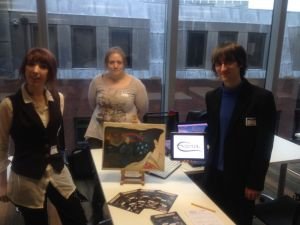 |
Everture Studios |
Everture Studios’ game didn’t appear to have a title yet and, as the team themselves acknowledged, their demo was a little on the limited side, only allowing players to walk a Chinese monk around a handful of small temple locations. Even in this limited form, however, the beauty of the cartoon artwork and the fluidity of movement was good to see. In appearances at least, this is undoubtedly a game with potential. To demonstrate the game's tone and setting, the developers were handing out leaflets showing an adaptation of the Zen kōan, The Moon Cannot be Stolen. Whilst often perceived as meaningless statements in the Western world, these are used to test students’ understanding of Zen practice by provoking the “Great Doubt”. Given the central character of the game is intended to be a Zen Buddhist monk , this illustrates the mood that the game aims to depict.
Even with this potential on display, you would be forgiven for thinking that the team should have waited until next year when they had something more concrete to show. But the reason they made the effort to come this year was simple. Were it not for AdventureX, Everture Studios would probably not exist at all. At the 2012 convention, a group of budding developers were looking for a script writer to round off the pool of talents they had already. They found just the man for the job in the form of Gotz Heinrich, who presented a talk last year on how adventures and visual novels could interact. It may be early days, and their website does only have a home page at present. But with the inspiration AdventureX has obviously inspired, and the good work shown so far, I have high hopes for this team.
Hungry Whispers
Dr Yu Ling is taking a train home as he tries to recover from a traumatic incident. His dreams are haunted by visions of the young boy he accidentally killed. On indefinite leave due to the mental trauma, he hopes that the support of his family, especially his sister Kami, will enable him to work again. Then Kami disappears, and Dr Ling must set off on a quest to find her. But this is “Ghost Month”, the time of year when spirits are said to walk the earth for a while before returning to hell. As his search for his lost sibling continues, he finds that he may be in far more danger than he realises.
 |
Card from Hungry Whispers
|
This game from JDWasabi Studios is a visual novel with a creepy overtone. The demo at the convention started with an unpleasant dream sequence, setting the tone for the adventure. This feeling was well supported by the haunting piano music backing the visions. The playable part of the demo comprised the train journey and required interactions with other passengers, including a young boy that reminded Dr Ling of his deceased patient. Puzzles were fairly light, though drawing a picture of an elephant for the young boy using a touchpad was trickier than I anticipated. Apart from the opening dream, there weren’t a great deal of horror elements that on display. However, some fine art cards on sale captured both the general look of the graphics and, with strange shapes lurking behind the lead character, the feel. You can follow further production on the developer’s Deviant Art feed.
Choose Your Own AdventureX
Last year’s AdventureX revealed the adventures of the brave Spice Mage, Steve-Batman. Having thoroughly enjoyed the bizarre tale of my almost name-sake, I looked forward to what Alasdair Beckett-King and co-writer Barry Ferns had brought us this year. They did not disappoint. Once more, a room full of intrepid adventure game fans shouted out their choice of commands to direct a surreal story. Based on these choices, with a captain chosen as final arbiter for disputes, Alasdair led us on another magnificent adventure. With various aspects of the lead character determined by audience vote, our protagonist this time around was a heroine, the oddly named Boris, Lord of the Owls. Not letting her handicaps of having three massive feet and no clothes get in her way, Boris bravely leapt into a tale of hooded figures, robotic royalty and officious beefeaters. By the end of the game we had laid waste to the British royal family, thwarted a dastardly plot and gained a new love interest. Whilst our adventure could be said to have had a successful conclusion overall, the mayhem and destruction we left in our wake may indicate that none of us should stand for parliament any time soon.
 |
Alasdair Beckett-King once again leads an entertaining Choose Your Own AdventureX |
This year the cartoon-style graphics of the 2012 adventure were changed to something more akin to a cardboard puppet theatre. With a projector screen standing in for the computer monitor, the stage was set with the curtain drapes of a theatre. Whilst major scenes changes were hidden behind a curtain, characters slid onto “stage” from both wings or, like Boris’ pet owl, dropped in from the ceiling. Both characters and scenery were created from what looked like photographic stills, hand-coloured to create that true puppet theatre look. Our heroine was a fine piece of classic art, its antiquity justifying her unashamed nakedness, though she maintained a mostly demure pose throughout. Our adventures took us from her mundane office, where she was fired at the start, up to the surface of the moon. Sound effects, including a variety of voices, were provided by Alasdair himself with varying, though always amusing, degrees of success. Puzzles included proving our patriotism by answering a series of questions and locating an impostor using an inexplicably lethal detection device.
Sadly for those wishing to recreate the event for themselves, the game is not available for download this year. This is because the experience is soon to be taken to a wider audience, with Alasdair planning live shows at The Camden Head in Angel, London. Whilst details of dates are still to be confirmed, those in the area should call for the opportunity to get the full experience presented by the man himself. Check out the open mike dates on the Camden Head website. For those that want a Choose Your Own fix anyway, check out my poetic game inspired by Alasdair’s antics by clicking the image below.
Stephen Brown's Choose Your Own... PoemX! (Click to download)
PlayIR
It wasn’t just games that were being demoed at AdventureX. Ashraf Ramy Hegar was there to show off his real-time development platform PlayIR. With the IR standing for “In Real-time” this multi-engine platform allows changes to be made to games even while players are playing them. With the developer able to make adjustments via both web and mobile applications, bug fixes and new features can be done on the go.
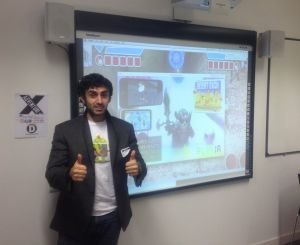 |
PlayIR creator Ashraf Ramy Hegar |
Ashraf ran through the basics of the tool. The program comes with a number of basic templates to start the user off. These include such popular game styles as fighting, shooting and racing games. Once the player has picked a base template, they can modify the look of the game and characters with simple mapping of graphics files. Grabbing a graphic from an AdventureX promo and dropping it into a fighting game instantly changed the arena floor into that graphic. Objects can also be added to the playing field with similar mechanics, and reshaped in place. Our AdventureX arena sprouted a variety of columns across its surface in a matter of seconds.
Interactions between characters were also easily redefined, with a mouse-click or finger tap changing an exchange from shouting a taunt to initiating combat by just changing a few settings. Having picked a particular template to begin with doesn’t limit what you can do. Adding shooter mechanics to a racing game to allow inter-player combat simply involves importing those features from the shooter template. You don’t even have to hand out these powers to all characters; you can give a fighter-based character a tough challenge in approaching a shooter, for example. The programming language of the engine is based on Javascript, but all the functions have button interfaces too for the non-programming user. The less confident designer can even elect to keep changes offline temporarily, importing them wholesale into the live game when they are ready.
I suspect that, in its current form, PlayIR is still a bit limited for major game development. However, this could certainly be an engine with promise. The inclusion of royalty-free assets and open source game packs make this readily accessible for a budding developer wanting to create a simple game for their friends. The live updating undoubtedly also makes it suitable for table-top roleplaying where players cannot physically get together. A dungeon master making live updates to a world the players are travelling through could really help give a sense of actually being there. What we saw displayed is still a relatively early version of the engine, so the potential for greater complexity in future game-making is there. The ability to make changes in real-time, even in released versions of a game, makes testing new features on a live audience a snap. I hope to see more development of this engine down the road, and that a future AdventureX visit will bring an adventure game written on it.
Those wishing to check out PlayIR and follow its further development should check out the engine website.
Versu
Emily Short might be best known for her text adventure Galathea, but she wrote many more. A common denominator in her games is the emotional and psychological depth of their characters. In her talk, Emily explained the basis for the software she is working on at Linden Labs (the company behind Second Life, amongst others) together with Richard Evans, who was the lead designer for The Sims 3. Where other design systems focus on building rooms and objects, their tool called Versu is about dialogue-driven narrative, including the way characters respond to the player and the way they are treated. As an example, Emily described an advertising agency where a female employee did not want to create a sexist campaign, but nor did she want to lose her job by flatly refusing. There were multiple options to choose from, not only conversational topics but also “shrug”, “fidget”, “bite nails”, etc. Each of these would have a different effect on the manager, and the script had several endings. Versu's ultimate goal is to have interactive characters act as puzzles instead of simply blocking the path with a quest.
With each choice the player makes, the underlying simulator keeps track of the relationship that develops between the characters (are they friends or not, do they trust each other?) and that influences the available dialogue options. Everything in games developed with Versu will be modelled on their social meaning, compared to being object-oriented. The tool has a built-in testing facility that runs the script hundreds or thousands of times, making random choices. By looking at the number of times any specific choice has been made, it is possible to pinpoint events that will never happen because the combination of choices that have to be made in order to make it happen is invalid.
Astrid Beulink and Stephen Brown contributed to this article.






